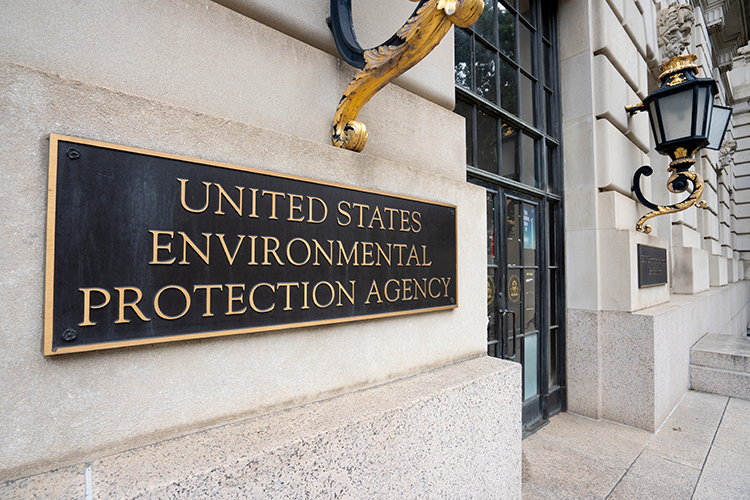SCOTUS blocks EPA's 'downwind' air-quality initiative

The Supreme Court dealt a blow to the Environmental Protection Agency's regulation of air quality on Thursday, putting on hold a major initiative to improve public health by reducing smog-forming pollution from power plants and factories that blows across state lines. (Image from Shutterstock.)
The Supreme Court dealt a blow to the Environmental Protection Agency’s regulation of air quality on Thursday, putting on hold a major initiative to improve public health by reducing smog-forming pollution from power plants and factories that blows across state lines.
The decision is the third time in as many years that the court’s conservative majority has sharply challenged the EPA’s power to regulate pollution, following rulings in 2022 and 2023 that targeted the agency’s ability to limit greenhouse gases and protect wetlands from runoff.
In this year’s case, a divided court sided 5-4 with states, trade associations and companies that asked for a pause on the agency’s ambitious “good neighbor” plan as they challenge it in a lower court.
The way the decision was made was notable: The justices took up the case on an emergency basis while it is still playing out in the U.S. Court of Appeals for the D.C. Circuit. Usually, the high court waits for proceedings to finish in lower courts before taking up such challenges.
That move angered liberal justices and environmentalists, who questioned what was so urgent when the regulations do not go into effect until mid-2026. They also said the ruling could embolden industry to challenge other regulations before they launch. The Supreme Court typically accepts challenges to such rules only after they go into effect.
The states of Ohio, Indiana and West Virginia, and other groups asking for a hold on the plan, argued that it was unworkable and illegal, would require industries to spend billions for upgrades to cut pollution, and could even lead to power and heating shortages by forcing plants to shutter.
The EPA contended that those concerns were unfounded and said the plan is critical for the health of residents in downwind states, particularly the young and elderly, who are susceptible to asthma, emphysema and other lung diseases exacerbated by ground-level ozone, the main component of smog.
But most of the court’s conservatives, led by Justice Neil M. Gorsuch, rejected the EPA’s contention.
“Put simply, EPA’s response did not address the applicants’ concern so much as sidestep it,” Gorsuch wrote in the majority opinion.
The agency estimates the plan could remove 70,000 tons of nitrogen oxide, an ozone-forming pollutant, from the air by summer 2026; prevent as many as 1,300 premature deaths; and reduce emergency room visits.
The EPA said in a statement that it was disappointed in the ruling, but looked forward to defending the plan as the lawsuit over it continues in the lower court.
While the initiative is on pause, the agency said, “Americans will continue to be exposed to higher levels of ground-level ozone, resulting in costly public health impacts that can be especially harmful to children and older adults and disproportionately affect people of color, families with low-incomes, and other vulnerable populations.”
West Virginia Attorney General Patrick Morrisey (R) applauded the decision. “The country’s power grid is already stressed as it is, and now this administration is attempting to add more regulation that’s going to stress the grid even more,” Morrisey said in a statement. “This decision by the Supreme Court is correct but the EPA will keep trying to legislate and bypass Congress’s authority.”
The case grew out of the EPA’s implementation of a section of the Clean Air Act that requires sources of pollution in upwind states to curb their emissions if they are affecting the air quality in downwind states. Prevailing west-to-east winds can carry pollutants hundreds of miles across the country.
The rule has been a source of tension between Midwest and Appalachian states, and those on the East Coast, where pollution often ends up. It has also evoked political divisions—Republicans often complain that the rule saddles industry with onerous expenses, while Democrats typically applaud the health and environmental benefits.
In 2015, the EPA strengthened air quality standards for ozone pollution, requiring states to submit plans to comply. The EPA found the plans to reduce pollution in most states were inadequate, so the Biden administration announced rules for 23 states in 2023 as required by the law. The rules limit emissions from power plants, steel mills, cement factories and other industrial polluters.
In separate litigation, 12 states challenged the EPA’s disapproval of their plans in court and won stays. The plaintiffs in this case went a different route: They challenged the plan in the D.C. Circuit Court, arguing that it was arbitrary and capricious, and sought a stay pending the review.
The plaintiffs said it was unclear how the plan would work if 12 states were no longer subject to it and challenged its adequacy on other technical grounds. The D.C. Circuit Court denied the stay and the petitioners submitted their emergency request to the Supreme Court while the main case is playing out in the lower court.
The Supreme Court agreed to hear the request, but went a step further, saying it would also consider whether it is reasonable to do so before a lower court had suspended the rule.
Downwind states such as Maryland, New York, Wisconsin and Pennsylvania filed a friend of the court brief in the case, saying pollution that wafts into their states from upwind sources has major health consequences for their residents. They said it also makes it difficult for them to meet federal air quality guidelines and will force them to implement even stricter controls on their own sources of pollution—at great expense—to comply with the rules.
The ruling once again demonstrates the skepticism with which the Supreme Court’s conservative majority views federal regulation not specifically approved by Congress, and the justices’ willingness to curb the power of federal agencies. In a separate ruling Thursday, the court struck down the legality of in-house tribunals the Securities and Exchange Commission uses to handle securities fraud cases.
The court has not yet ruled on a challenge to the legal precedent known as Chevron deference, which holds that courts defer to federal agencies on reasonable interpretations of ambiguous statutes. In May, the Supreme Court gave a win to federal agencies, ruling that the funding mechanism for the powerful Consumer Financial Protection Bureau is constitutional.
Write a letter to the editor, share a story tip or update, or report an error.



